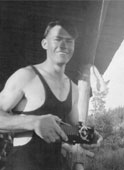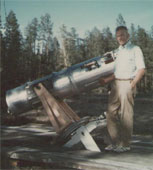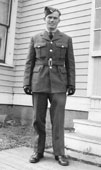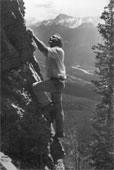Hank Langstaff

Hank was born in Yorkton, Saskatchewan in 1913. The doctor that delivered him and the attending nurse were named Henry and Harding, not sure who was who. In any case, they named him after both of them and he officially became Henry Harding Langstaff. He came to be called Harding by everyone, which was a name he always disliked, so when he joined the Air Force and went to England, he changed his name to Hank.
Due to his growing up on the farm and his subsequent years working in the bush camps, he became muscular and very tough and yet his demeanor was always calm and gentle. His huge hands laid testament to his years of hard work. Even at the Air Force base where he was stationed, if they needed a strong arm, they called on Hank. No one else was equal to the task.
Remembering Hank
………………………………………………………………………………………..by Michael Wilmot, 2002
In 1955, as a new brother-in-law, I first met Hank standing at the Melville railway station in Yorkton, Saskatchewan. Sheila and I stayed in his home until getting established in Canada. He was a man of many talents and experiences. He had a brilliant scientific mind and made full use of it in many projects. He could turn his hand to anything. Hank was very frugal as a result of experiences during the depression years. The more it cost, the more he turned his hand to fixing it. But, by the same time he was very generous and helpful to others.

Nothing ever seemed to faze him and on the surface he always gave the appearance of being calm and laid back. One time, asking him about this, he joked “I am a seething turmoil inside”. Over the years, he was physically fit, very strong and powerful. This strength, he put to full use both in his work and in his social activities. Skiing and hiking were among his favourite pastimes along with water skiing. Hobbies included astronomy, where he ground large mirrors by hand and made his own telescopes for viewing and tracking the stars. A past president of the Royal Astronomical Society of Calgary, other hobbies included photography, electronics, music, learning Spanish and doing crosswords. He was quite an accomplished pool player and squaredancer.

He was the son of a farmer who lost their farm in the thirties. So, as a young man, he rode the rails to Ontario. He then canoed into Red Lake and obtained work, first in a gold mine and then in the woods. Living the life of a bushman, he lived summer and winter in sometimes freezing conditions. While in Red Lake, he met a life-long friend Lorne Mckenna, and together, they built five or six log cabins to rent out to the gold miners. Along the way, he also got involved with radios.

With the commencement of World War 2, he joined the Air Force and was sent to the Radio College of Canada in Montreal where he received extensive training in electronics. From there he was sent to England where he worked on radar in Bomber Command. While in England, he met Joyce Ward who was serving in the R.A.F. After the war in Europe, he was sent back to Canada to get demobbed. After this, he returned to England to marry Joyce. To get to England, he went to Montreal and signed on to work his passage on a cattle boat bringing horses and cattle to Europe from North America. After marrying Joyce, he got work building brick homes in England. Not being familiar with this type of building, he would go to the library at night and read up on how to do his next day’s project. One incident I remember his telling me was about a chimney he had built. Upon completion, it collapsed!
In 1947, he moved back to Canada with Joyce and one-year-old Christine. In Saskatchewan, he became a construction supervisor. Some of the projects he was involved in were the hospital and dam in Moosomin as well as the Royalite gas stations. In between times, he was a one-man-band. He built a basement under his house, digging it out with a shovel and a wheelbarrow, then pouring the cement walls by hand. He repeated this years later on his lake home at Shuswap, then also dug down on his property to put in a septic tank.

During his years in Yorkton, he did extensive modifications to his house. On one occasion, while Joyce was on a trip to England, he decided to extend the ground floor space; which he did. On her return eight months later, Joyce was horrified to learn from her neighbors that all the house furnishings were left outside on the lawn while Hank did his job. A few years later, he decided to change the house from a two-story to a one-story dwelling. This was just prior to moving the family to Calgary.
In Calgary, he got into electronics again and set up his first shop on the Old Banff Coach Road called the “TV and Radio Clinic”. A few years later, he got into partnership with Don Mitchell, who owned a different electronics shop, and moved across the street (now called Bow Trail) and together, operated a larger store called the “Southwest TV Centre”.

During his years in Calgary, he pursued many activities including skiing, mountaineering and astronomy. He and Joyce retired in 1976 and moved out to their cabin on the Little Shuswap Lake.
They enjoyed an active retirement, spending many winters as “Snowbirds”, traveling to California, Arizona and Mexico. He continued remodeling the lake cabin, eventually extending it into a full-sized home. The original cabin had been built around three trees with the largest, a Ponderosa pine, growing right through the kitchen. This, he removed himself by climbing up and removing it in sections. He dug out the extensive root system under the house to make way for a chimney and a wood furnace. He spent much time in the summers going out in his boat to fetch floating logs for winter firewood. He continued with his renovations until just prior to his passing.
It can be said that you pass this way but once, but if you missed Hank, you missed part of life. His long life is part of Canadian history and should have been recorded for all.